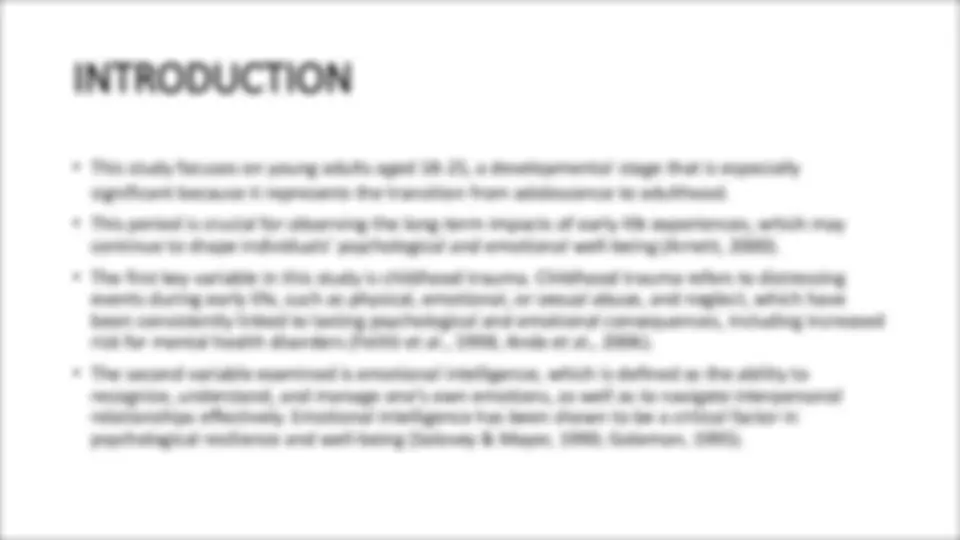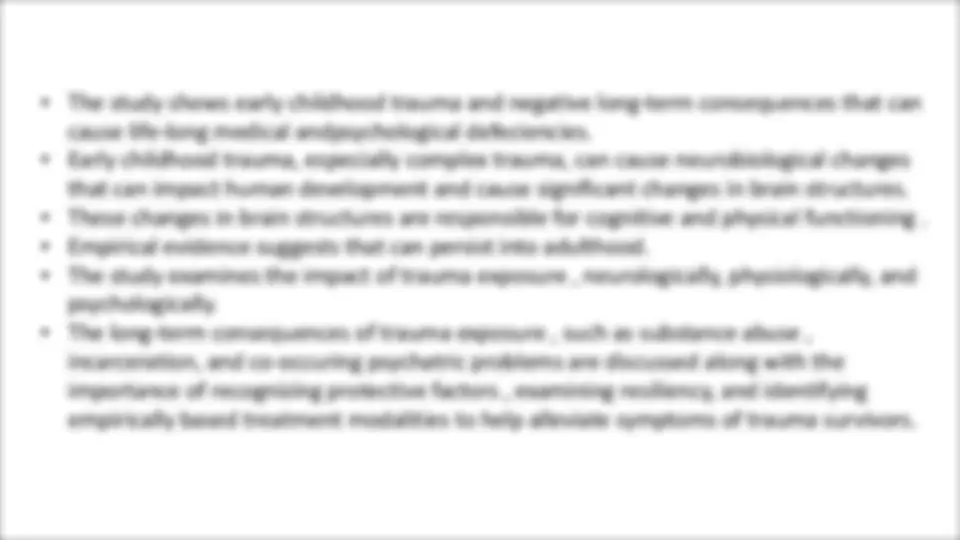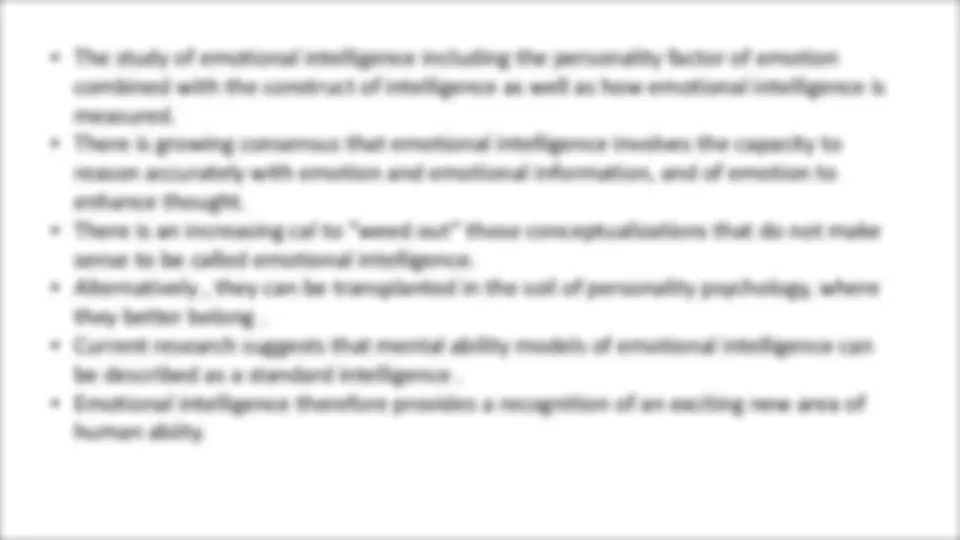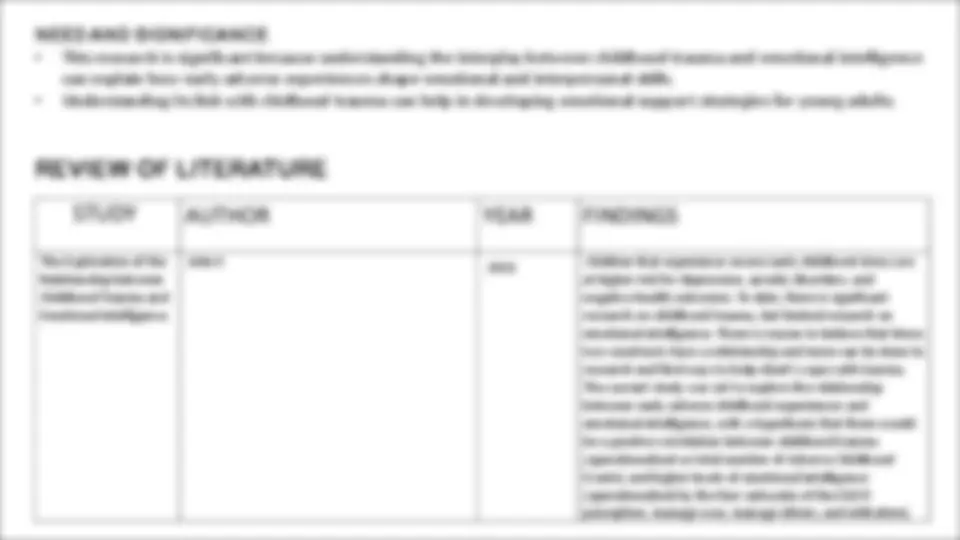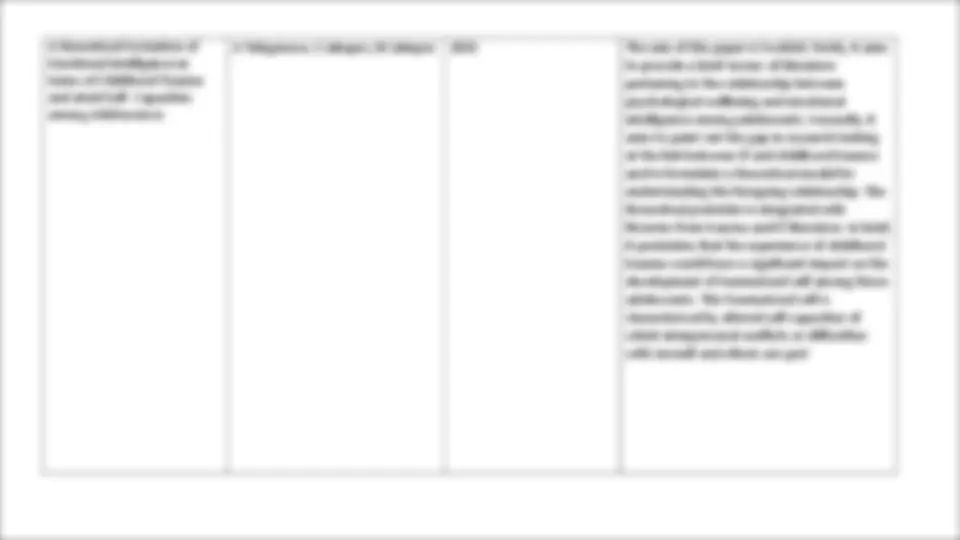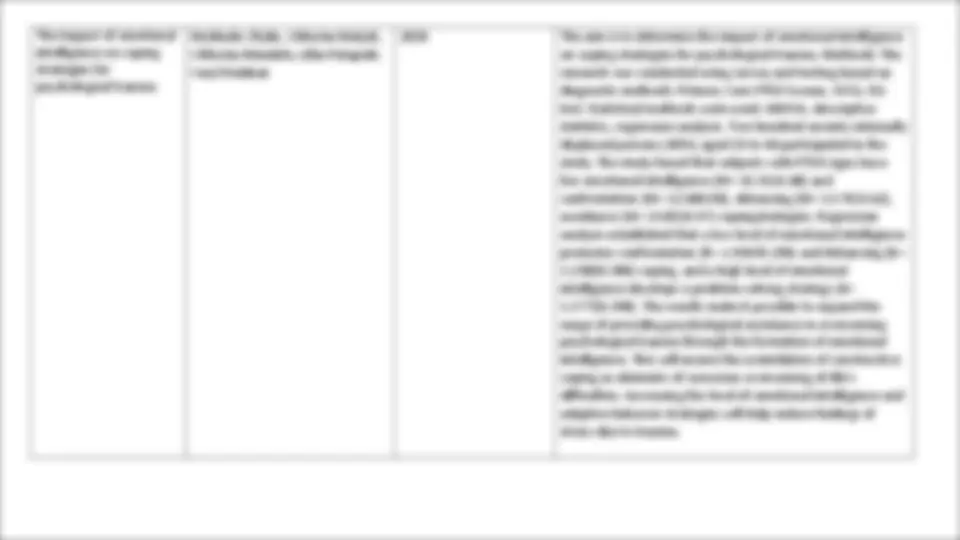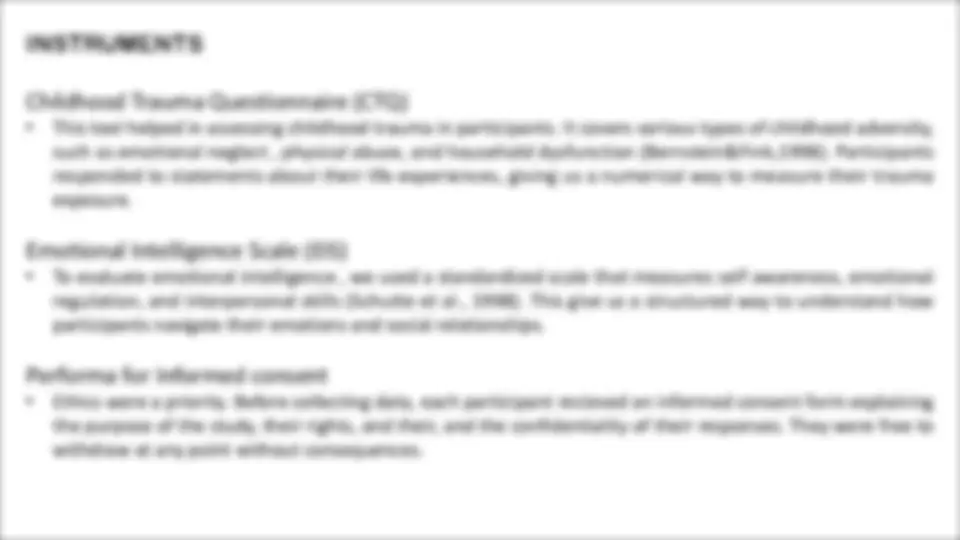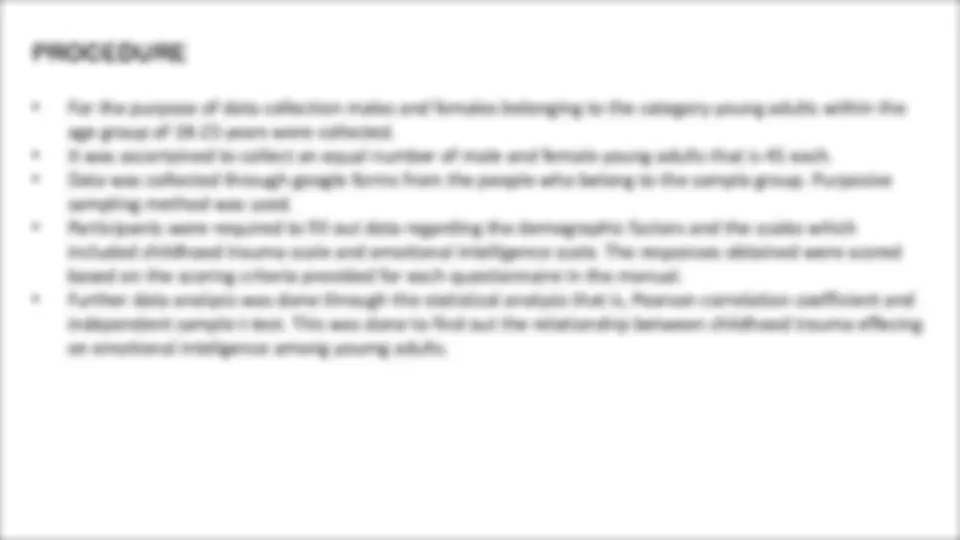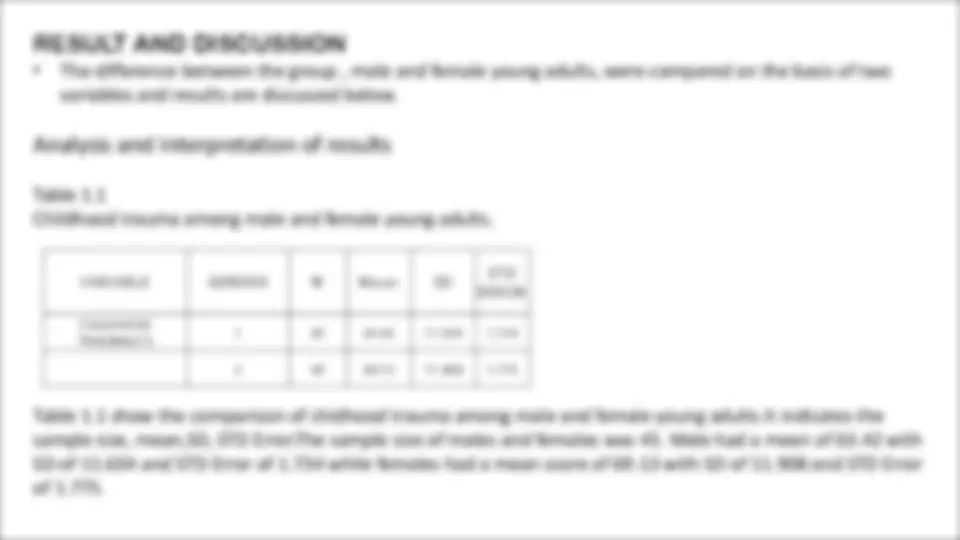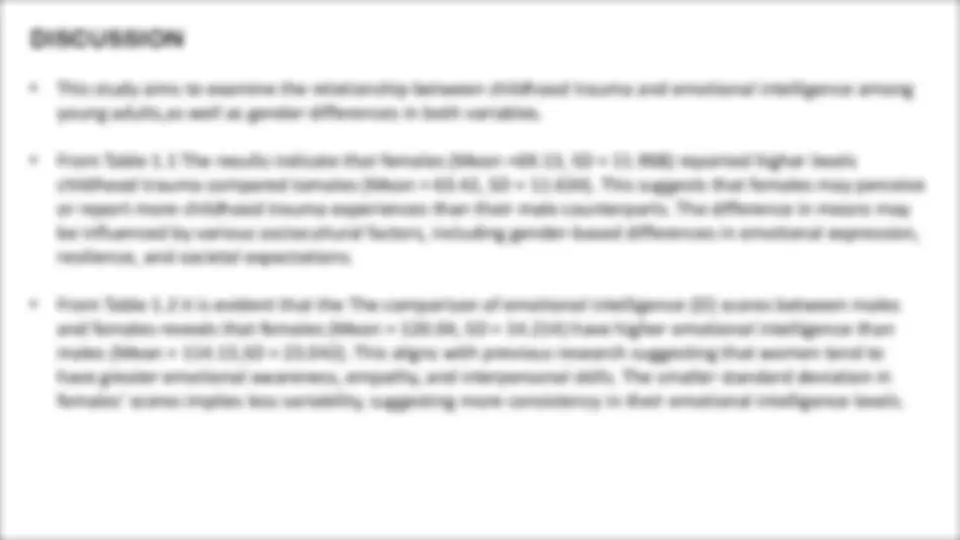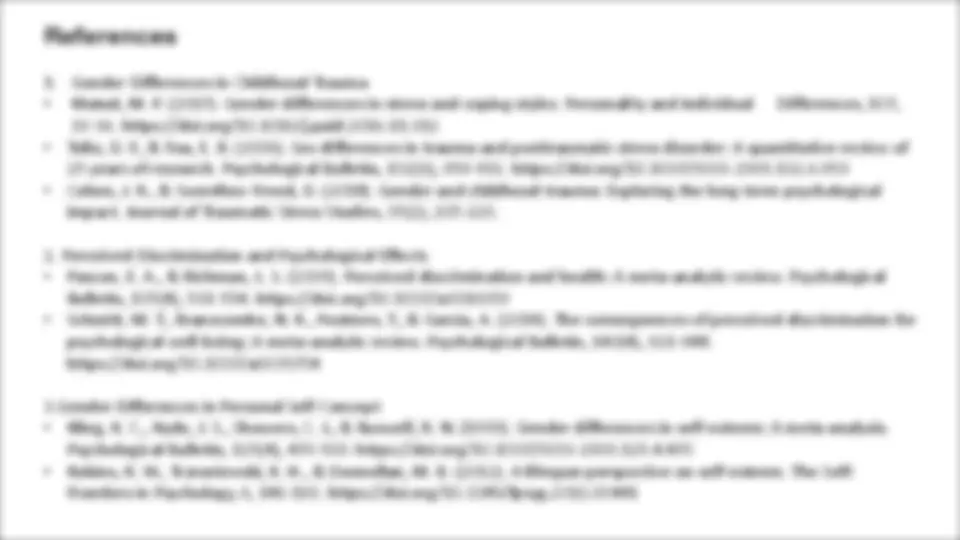Download Childhood Trauma and Emotional Intelligence in Young Adults: A Research Proposal and more Study Guides, Projects, Research Psychology in PDF only on Docsity!
Ashmi Rajan , Sanaya Santhosh , Anjana K J
INTRODUCTION
- This study was conducted on young adults aged 18-25.
- This age group is particuarly significant because it marks the transition from adoloscence
to adulthood a period during which the long term effects of early life experiences can be
observed.
- The first key variable is chidhood trauma.
- Childhood trauma refers to distressing experiencesin early life- such as physical,emotional,
or sexual abuse, or neglect- that can have lasting psychological and emotional effects.
- The second variable in our study is emotional intelligence.
- Emotional intelligence is the ability to recognize, understand, and manage one’s emotions,
as well as effectivey navigate interpersonal relationships
- The study shows early childhood trauma and negative long-term consequences that can
cause life-long medical andpsychological defeciencies.
- Early childhood trauma, especially complex trauma, can cause neurobiological changes
that can impact human development and cause significant changes in brain structures.
- These changes in brain structures are responsible for cognitive and physical functioning.
- Empirical evidence suggests that can persist into adulthood.
- The study examines the impact of trauma exposure , neurologically, physiologically, and
psychologically.
- The long-term consequences of trauma exposure , such as substance abuse ,
incarceration, and co-occuring psychatric problems are discussed along with the
importance of recognizing protective factors , examining resiliency, and identifying
empirically based treatment modalities to help alleviate symptoms of trauma survivors.
- The study of emotional intelligence including the personality factor of emotion
combined with the construct of intelligence as well as how emotional intelligence is
measured.
- There is growing consensus that emotional intelligence involves the capacity to
reason accurately with emotion and emotional information, and of emotion to
enhance thought.
- There is an increasing cal to “weed out” those conceptualizations that do not make
sense to be called emotional intelligence.
- Alternatively , they can be transplanted in the soil of personality psychology, where
they better belong.
- Current research suggests that mental ability models of emotional intelligence can
be described as a standard intelligence.
- Emotional intelligence therefore provides a recognition of an exciting new area of
human abiity.
HYPOTHESIS
- H1: There is no significant relationship between childhood trauma and emotional intelligence.
- H2:There is no significant difference in childhood trauma between male and female young adults.
- H3:There is no significant difference in emotional intelligence between male and female young adults.
OPERATIONAL DEFENITIONS
- Childhood Trauma: This refers to distressing experiences during early life, such as emotional neglect , physical abuse, or growing up in a chaotic environment.these experiences can shape a persons emotional and psychological development, sometimes leaving a lasting effects on how they handle relationships and stress (Felitti et al.,1998).
- Emotional Intelligence: Think of EI as the ability to read the room understanding one’s emotions managing them effectively, and responding to others with empathy and social awareness. People with high EI can regulate their emotions under pressure and navigate social interactions smoothly (Goleman, 1995).
- Young Adults:In this study young adults refers to individuals between 18-25 years old- college students who are in a transitional phase between adoloscence and full independence.This stage is crucial as they develop emotional and social skills that will shape their future personal and proffesional lives.
NEED AND SIGNIFICANCE
- This research is significant because understanding the interplay between childhood trauma and emotional intelligence can explain how early adverse experiences shape emotional and interpersonal skills.
- Understanding its link with chidhood trauma can help in developing emotional support strategies for young adults.
REVIEW OF LITERATURE
STUDY AUTHOR YEAR FINDINGS
The Exploration of the Relationship between Childhood Trauma and Emotional Intelligence John F. 2021 Children that experience severe early childhood stress are at higher risk for depression, anxiety disorders, and negative health outcomes. To date, there is significant research on childhood trauma, but limited research on emotional intelligence. There is reason to believe that these two constructs have a relationship and more can be done to research and find ways to help client's cope with trauma. The current study was set to explore the relationship between early adverse childhood experiences and emotional intelligence, with a hypothesis that there would be a positive correlation between childhood trauma (operationalized as total number of Adverse Childhood Events) and higher levels of emotional intelligence (operationalized by the four subscales of the SSEIT: perception, manage own, manage others, and utilization).
The Impact of emotional intelligence on coping strategies for psychological trauma Mykhailo Zhylin, Viktoriia Malysh, Viktoriia Mendelo, Liliia Potapuik, Vasyl Halahan 2024 The aim is to determine the impact of emotional intelligence on coping strategies for psychological trauma. Methods: The research was conducted using survey and testing based on diagnostic methods: Primary Care PTSD Screen, WCQ, EQ- test. Statistical methods were used: ANOVA, descriptive statistics, regression analysis. Two hundred seventy internally displaced persons (IDPs) aged 23 to 48 participated in the study. The study found that subjects with PTSD signs have low emotional intelligence (M= 32.3114.88) and confrontation (M= 12.684.08), distancing (M= 12.74$4.62), avoidance (M= 13.85$4.97) copingstrategies. Regression analysis established that a low level of emotional intelligence promotes confrontation (ß=-1.926‡0.296) and distancing (B=- 1.198$0.386) coping, and a high level of emotional intelligence develops a problem-solving strategy (B= 1.277$0.298). The results make it possible to expand the range of providing psychological assistance in overcoming psychological trauma through the formation of emotional intelligence. This will ensure the assimilation of constructive coping as elements of conscious overcoming of life's difficulties. Increasing the level of emotional intelligence and adaptive behavior strategies will help reduce feelings of stress due to trauma.
METHOD
RESEARCH DESIGN
- For the purpose of data collection quantitative, correlational research design was used to examine the relationship between childhood trauma and emotional intelligence. This
SAMPLE
- The participants were 90 young adults , aged 18-25. Instead of selecting individuals based on whether they had experienced trauma, the sample included a random selection of students from diverse backgrounds. This allowed us to explore how childhood trauma and emotional intelligence interact in general young adult population.
SAMPLING METHOD
- Stratified random sampling is used to ensure balanced gender representation.
SAMPLE FRAME
- Participants were required to have an indian citizenship and belonged to the category of young adults within the age group 18-25.
INSTRUMENTS
Childhood Trauma Questionnaire (CTQ)
- This tool helped in assessing childhood trauma in participants. It covers various types of childhood adversity, such as emotional neglect , physical abuse, and household dysfunction (Bernstein&Fink,1998). Participants responded to statements about their life experiences, giving us a numerical way to measure their trauma exposure.
Emotional Intelligence Scale (EIS)
- To evaluate emotional intelligence , we used a standardized scale that measures self awareness, emotional regulation, and interpersonal skills (Schutte et al., 1998). This give us a structured way to understand how participants navigate their emotions and social relationships.
Performa for Informed consent
- Ethics were a priority. Before collecting data, each participant recieved an informed consent form explaining the purpose of the study, their rights, and their, and the confidentiality of their responses. They were free to withdraw at any point without consequences.
PROCEDURE
- For the purpose of data collection males and females belonging to the category young adults within the age group of 18-25 years were collected.
- It was ascertained to collect an equal number of male and female young adults that is 45 each.
- Data was collected through google forms from the people who belong to the sample group. Purposive sampling method was used.
- Participants were required to fill out data regarding the demographic factors and the scales which included childhood trauma scale and emotional intelligence scale. The responses obtained were scored based on the scoring criteria provided for each questionnaire in the manual.
- Further data analysis was done through the statistical analysis that is, Pearson correlation coefficient and independent sample t-test. This was done to find out the relationship between childhood trauma effecing on emotional inteligence among youmg adults.
Table 1. Table 1.2 shows the comparison of emotional intelligence among male and female young adults. It indicates the sample size , mean , SD ,STD Error. The sample size of males and females was 45. Males had a mean of 23.042 with SD of 23.042 and STD Error of 3.435 while females had a mean score of 120.04 with SD of 2. ans STD Error of 2.119. EI (^) GENDER N Mean STD DEVIATION
STD ERROR
MEAN
Table 1. Table 1.1 shows the relationship between childhood trauma and emotional intelligence among young adults. It indicates the Pearson correlation , significance (two-tailed) , and the sample size , N. The correlation is 390 with a significance of 0.01 for the sample of 90 young adults.
CT CT EI
PEARSON
CORRELATION
SIG (2- TAILED) 000
N 90 90
EI PEARSON
CORRELATION
SIG ( 2- TAILED) 000
N 90 90
- From Table 1.3 it is evident that The Pearson correlation analysis between childhood trauma and emotional intelligence (r = .390, p=.000) indicatesa significant positive relationship. This suggests that individuals with higher childhood trauma scores also exhibit higher emotional intelligence. One possible explanation is that individuals who have experienced trauma may develop stronger emotional regulation and coping mechanisms as a means of adaptation. However, the directionality of this relationship requires further exploration.
CONCLUSION
The findings highlights a strong relationship between childhood trauma and emotional inteligence. Additionally,females reported higher levels of childhood trauma compared to males,while differences in emotional intelligence were not statistically significant. Future research could explore the underlying mechanisms that contribute to this correlation, including resilience and coping strategies developed by individuals who have experienced trauma.
References
- Gender Differences in Childhood Trauma
- Matud, M. P. (2017). Gender differences in stress and coping styles. Personality and Individual Differences, 107, 30-36. https://doi.org/10.1016/j.paid.2016.11.
- Tolin, D. F., & Foa, E. B. (2006). Sex differences in trauma and posttraumatic stress disorder: A quantitative review of 25 years of research. Psychological Bulletin, 132(6), 959-992. https://doi.org/10.1037/0033-2909.132.6.
- Cohen, J. R., & Swerdlow-Freed, D. (2018). Gender and childhood trauma: Exploring the long-term psychological impact. Journal of Traumatic Stress Studies, 35(2), 205-220.
- Perceived Discrimination and Psychological Effects
- Pascoe, E. A., & Richman, L. S. (2009). Perceived discrimination and health: A meta-analytic review. Psychological Bulletin, 135(4), 531-554. https://doi.org/10.1037/a
- Schmitt, M. T., Branscombe, N. R., Postmes, T., & Garcia, A. (2014). The consequences of perceived discrimination for psychological well-being: A meta-analytic review. Psychological Bulletin, 140(4), 921-948. https://doi.org/10.1037/a 3.Gender Differences in Personal Self-Concept
- Kling, K. C., Hyde, J. S., Showers, C. J., & Buswell, B. N. (1999). Gender differences in self-esteem: A meta-analysis. Psychological Bulletin, 125(4), 470-500. https://doi.org/10.1037/0033-2909.125.4.
- Robins, R. W., Trzesniewski, K. H. , & Donnellan, M. B. (2012). A lifespan perspective on self-esteem. The Self: Frontiers in Psychology, 6, 146-160. https://doi.org/10.3389/fpsyg.2012.

